Home » Other Articles » Tuesday Treasures Index » Tuesday Treasures - March 2023 - Tuesday Treasures - March 2023
Tuesday Treasures - March 2023
TUESDAY 28 MARCH
The Great Western style of advertising
The Blogs we have created in these past few years have naturally exploited the treasure of material on GWR publicity and advertising we hold in the Great Western Trust Collection. Our archive seeks to contain the widest possible examples of this crucial part of the GWR in its pursuit of passenger custom, both in day-to-day travel to and from work, and for holidays. In the past we focused upon samples of GWR brochures, posters, booklets and much else, but today we examine their publicity in a publication not of their creation.
The illustration is that of pages 198 and 199 of the respected and much used annual issue of the boldly titled The Railway Diary and Officials' Directory for 1928 published by McCorquodale & Co Ltd, and then obtainable for three shillings and sixpence (37½p).
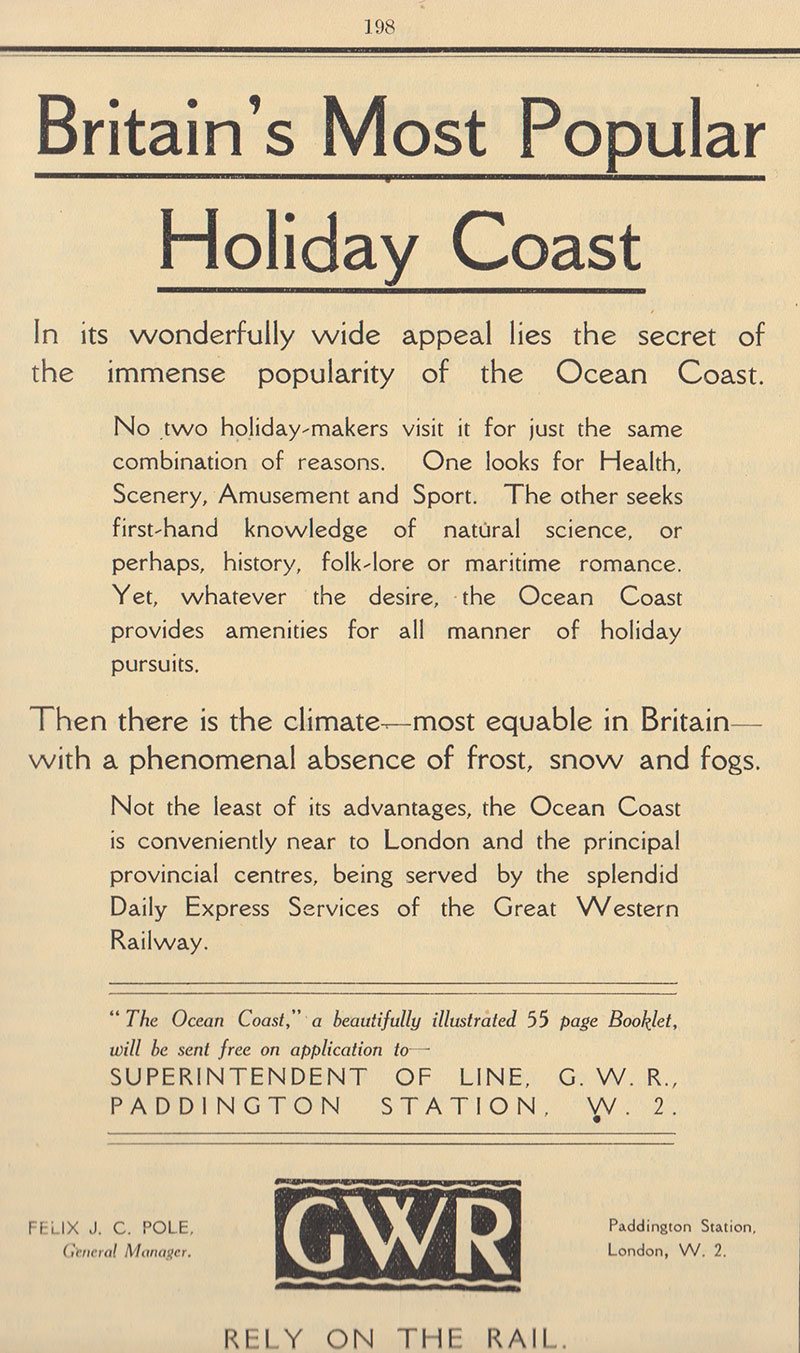
We leave the scanned pages to speak for themselves, in the equally boldly asserting tone then the mode of the GWR, but express our own surprise that beyond the holiday focus on page 198, whether the message on page 199 is really a little too forward as a suggestion to the original user of this commercial publication? After all, from its title and very extensive content, in which are detailed both Directors and Senior Officials of all the substantial railway companies together with a startling list of financial data even on wage tables, interest rates and taxes, all of direct relevance to its purchasing railway official, would they really appreciate the notice of ‘where to retire’ as a reminder of their senior years perhaps?
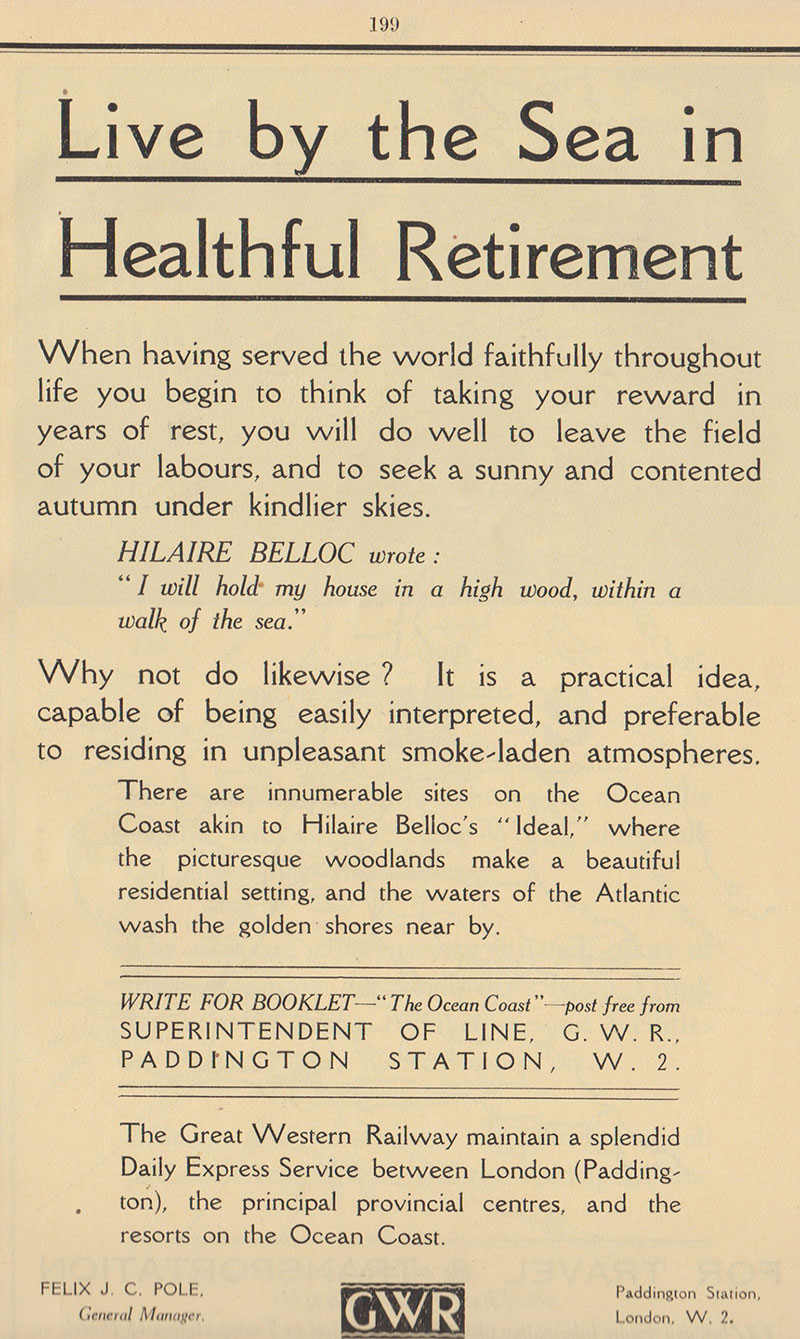
It is also questionable whether the lines written by Hilaire Belloc and quoted in the advert are geographically appropriate, taken as they are from his poem The South Country which is a paean of praise for Sussex!
It is also telling, that the LMS, LNER & SR, who also advertised on adjacent pages, chose to base their sales pitches upon their goods traffic services, surely a far more appropriate and expected contribution in such a publication? Well, as ever the case, the GWR rarely followed the crowd and maybe, this advert being so different from its peers, would arrest the attention of its readers after all?
In passing, the Trust collection holds many examples of this Diary, spanning from 1894 to 1937 which proves how popular, respected and useful it was for any railway official.
We are left to wonder if any such officials, took the GWR message to heart and enjoyed as they said ‘Healthful Retirement’ by the sea, in a location served by the GWR of course!
TUESDAY 21 MARCH
St Ives
This week we explore further the Great Western Trust collection of posters and journey to the far west. Beloved by artists for its light, and by generations of holidaymakers for its beaches, St Ives has been a favourite destination since the railway opened from St Erth in 1877. Indeed, the St Ives branch was the last pure broad gauge line to be built.

The poster shown here dates from 1935 and is unusual in being credited to both an artist and a photographer. The artist is Robert Borlase Smart, born in Kingsbridge, Devon in 1881. He was art editor on the Western Morning News during the Edwardian period and served in the Great War during which he produced charcoal and wash drawings depicting scenes of the carnage and destruction on the Western Front. After the war, now married, he moved to St Ives where he made a reputation as a fine painter and for the rest of his life was a pillar of the artistic community. He died in 1947.

The photographer is Daphne Pearson, a quite remarkable woman, born in Christchurch, Hants in 1911. She learnt to fly at a young age and must have taken the aerial photograph on which this poster is based when she was in her twenties. Shortly after the outbreak of the Second World War she joined the Women’s Auxiliary Air Force and in May 1940 performed an act of extreme bravery for which she was awarded the Empire Gallantry Medal.
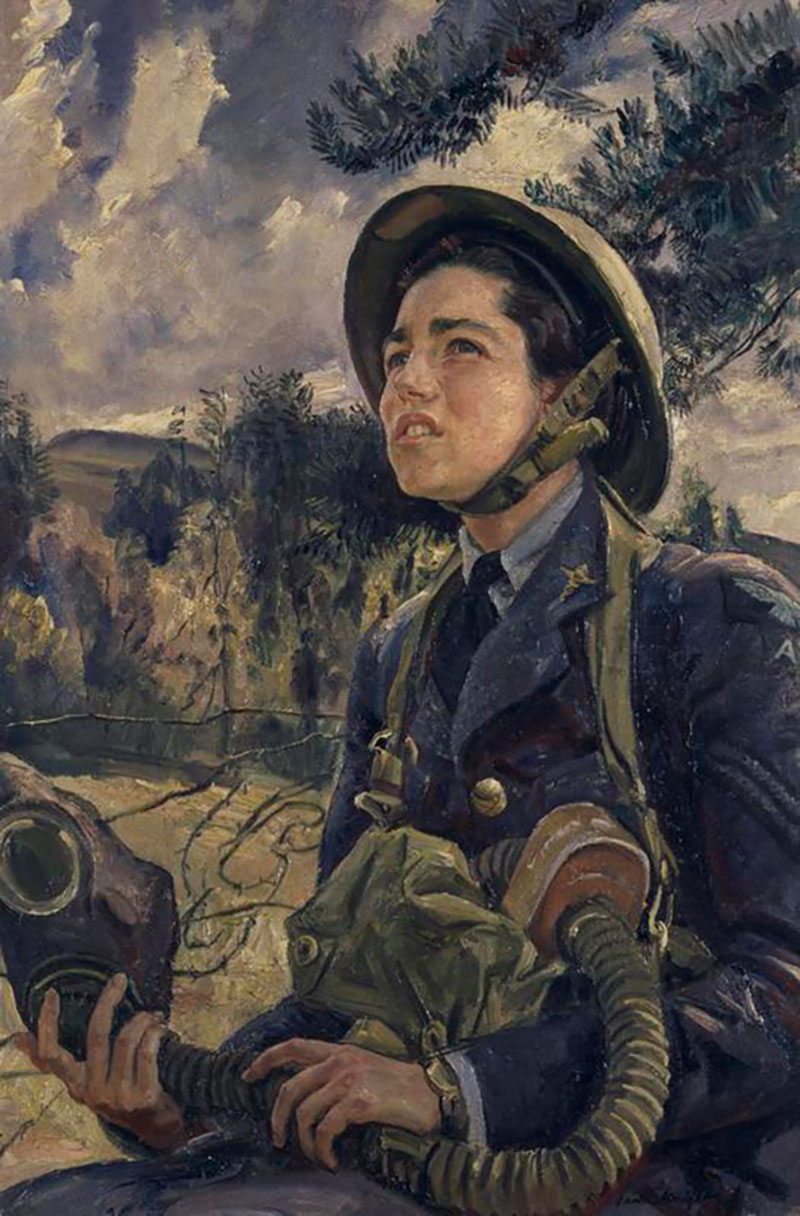
Corporal J. D. M. Pearson, GC, WAAF © IWM Art.IWM ART LD 626
The full citation for the award was published in the London Gazette on 19 July 1940 and reads:
CENTRAL CHANCERY OF THE ORDERS OF KNIGHTHOOD - St. James's Palace, S.W.1. 19th July 1940.
The KING has been graciously pleased to approve the following Awards: The Medal of the Military Division of the Most Excellent Order of the British Empire, for Gallantry:—
880538 Corporal (now Assistant Section Officer) Joan Daphne Mary Pearson, Women's Auxiliary Air Force
On 31 May 1940, an hour after midnight, an aircraft crashed near the Women's Auxiliary Air Force quarters at Detling in Kent, the pilot being seriously injured, another officer killed outright and two airmen slightly injured. Upon hearing the crash Corporal Pearson rushed out and, although she knew there were bombs on board, she stood on the wreckage, roused the pilot who was stunned, released his parachute harness and helped him to get clear. When she got him about 30 yards from the wreckage, a 120 lb bomb went off and Corporal Pearson threw herself on top of the pilot to protect him from the blast and splinters. She remained with him until a stretcher party arrived and then returned to the burning aircraft to look for the fourth member of the crew. She found him - the wireless operator - dead in the bomber. Her prompt and courageous action undoubtedly helped to save the pilot's life.
After the revocation of the EGM, King George VI invested Pearson on 31 January 1941 with its replacement, the George Cross.
Daphne Pearson spent the last thirty years of her life in Melbourne, Australia and died there in her ninetieth year.
Such stories demonstrate the wealth of social history just below the surface of the Trust’s collection.
TUESDAY 14 MARCH
The GWR Expansion in 1923
Today 100 years since it took effect, our Blog reflects upon the ‘Grouping’ of the Railways and the Great Western Railway's response.
The First World War saw the railways placed under state control, and that experience demonstrated to the government, and at least the largest railway companies, that a vast reduction in the numbers of independent ones created great operational efficiencies, and in theory at least, potential cost savings to the companies themselves and their passengers and trade customers.
The government seized the moment and by an Act of 1921, the railway companies were merged or ‘grouped’ with effect from January 1923. The GWR by a manoeuvre of Felix Pole, its General Manager, was alone of the four new consolidated companies in retaining its name, and hence was able in 1935 to celebrate its Centenary!
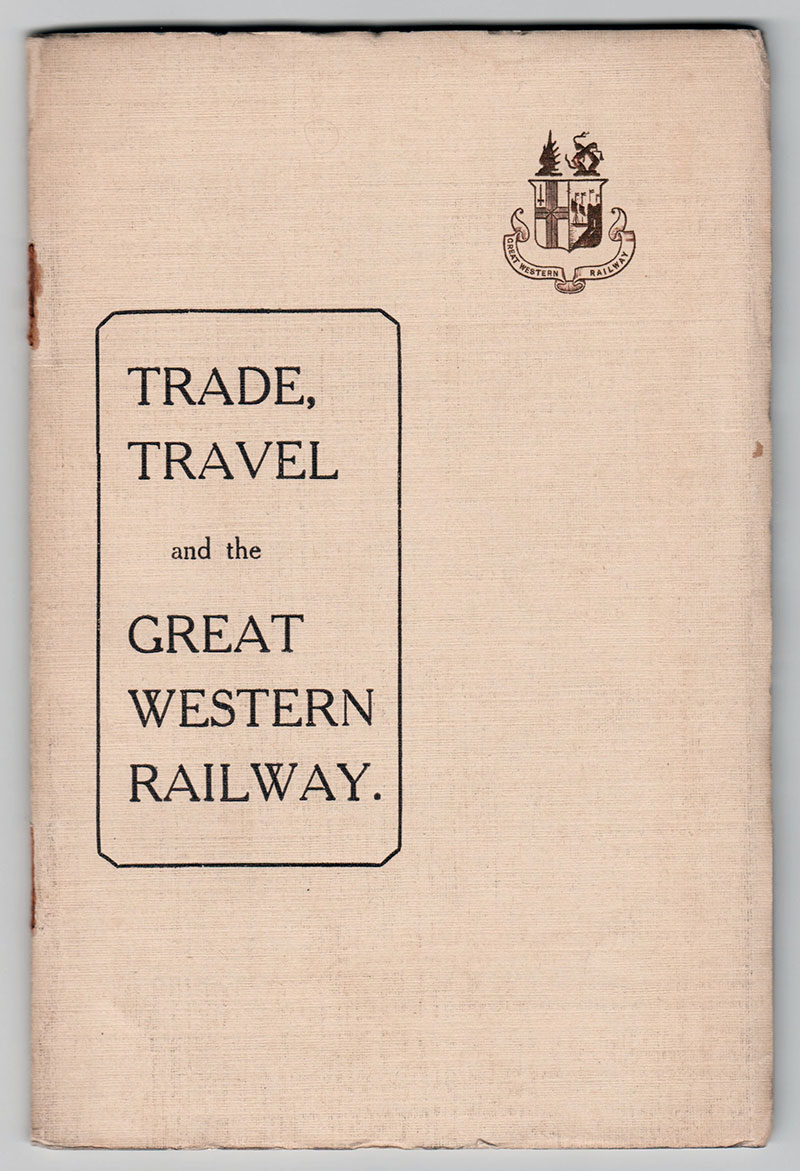
With a man so focused upon active engagement with commerce to gain additional trade benefit from such a massive expansion of the GWR, Pole had a high quality booklet published in April 1923, entitled ‘Trade, Travel and the Great Western Railway’ which was specifically meant to influence the Welsh commercial community to the new opportunities the GWR offered.
From an example in the Great Western Trust collection, we illustrate sections from that booklet, and some key statements within it. The cover title may be rather bland, but the title page is far more direct, as shown, “Concerning the Mutual Interests of the Trader, The Traveller and the GWR”.
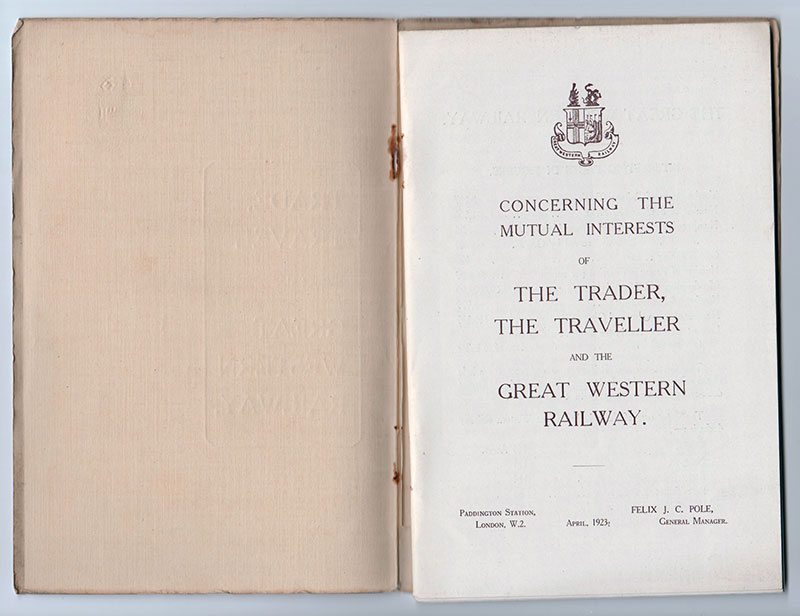
Reflecting the written style of its age, (Page 3 for example) which to our current eyes has an air of telling the reader what they really ought to already know and appreciate, the text goes far beyond extensive detail of the industries in the region and the individual products that the GWR system can carry for them, and the contact details of all GWR Agents, we have even in bold typeface the following lest the key message was still unclear…
“The interests of the trader is obviously therefore, to give the railway as much traffic as possible, and to co-operate in every possible way to prevent waste of expenditure.”
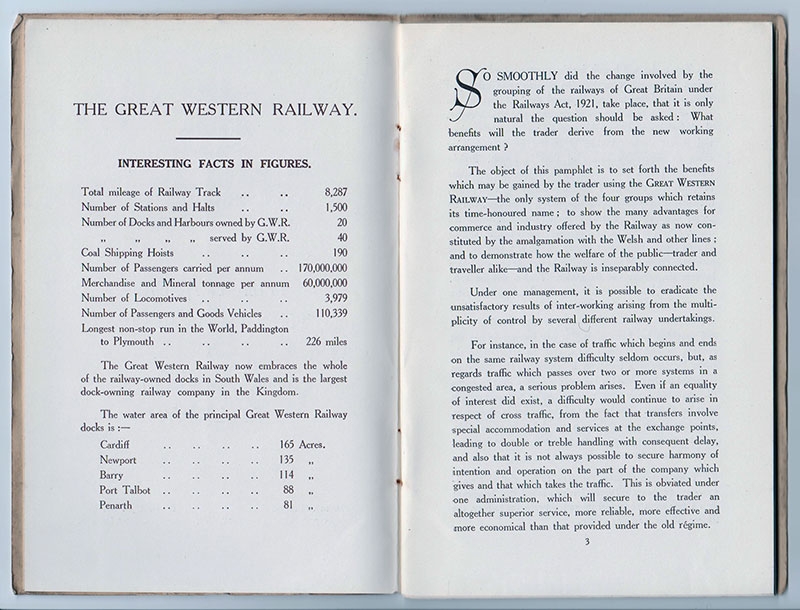
This booklet of 24 pages plus fold out GWR system map, in quality cream card covers, must have cost the company a significant sum in production and senior staff drafting of its wording. It was printed by the Western Mail, of Cardiff, a company much used by the GWR in later years. The Great Western Trust collection holds many other fine examples of the extensive efforts Pole personally pursued in reaching out to visit and influence the regional traders and in other ways pressed the expanded GWR staff to do as much as they could in that way at the local level.
The actual trade performance outcome was hardly as significant as once hoped for, nor in full reward for the GWR's massive investment in improved South Wales Docks facilities, because of world wide influences beyond its control. However, we have the benefit of hindsight, and one truth was obvious, over a hundred or more independent railway companies was not a sustainable option for a UK transport system, so removing that alone was indeed progress….
TUESDAY 7 MARCH
Railway Services and Local Garages
In our previous Blogs, examples have been taken from our Great Western Trust collection of the manner in which, first the GWR and then BRWR, pursued an approach to the motor car traffic threat to their train service usage and hence income, by providing car and occupants transport for longer distances mostly for the holiday season.
Today, we highlight a different relationship between commercial garage proprietors and the Great Western Railway that will we believe come as rather a surprise to our present generation.
We illustrate the cover advertising Station Garage, Taplow, and a sample of its pages of the GWR Local Timetable for December 1945 and printed locally by Smith & Baldwin of Maidenhead.
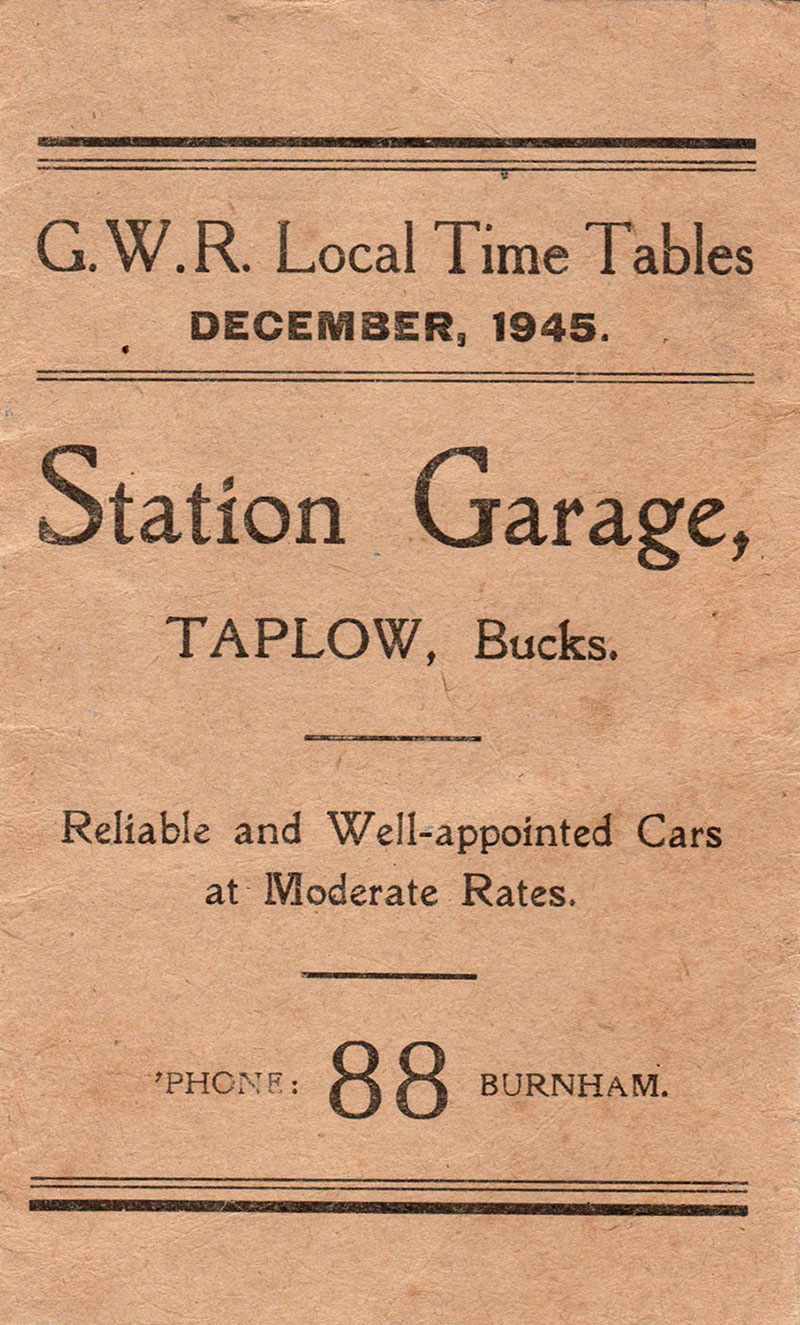
We need to set the context of December 1945 for this timetable. Petrol rationing had been introduced on outbreak of war in 1939, and was completely unavailable for private motoring after July 1942. A limited petrol ration for private use was reinstated in May 1945, but rationing remained in force until May 1950. That meant no alternative to train or bus for most journeys, so a summary timetable with the name of the business on the cover would be an effective marketing tool.
With new cars being virtually unobtainable (most production going for export to earn foreign currency) the Station Garage would have relied on hire of "reliable and well-appointed cars at moderate rates" to keep its business viable. It seems to be an example of integrated transport, with a car at the end of a call to Burnham 88 to complete the journey.
It was an era when those fortunate enough to have access to a telephone (most likely a public call box), would first dial the operator and ask to be put through to the exchange name ie ‘Burham’ and then the phone number! Rather a long way from subscriber automatic dialling or even mobile phones – but at least the combination of exchange name and a short number was easier to remember!
Strikingly, this card timetable was no cheap product, 3 inches wide x 4¾ inches high when folded and opening out to 7 pages to give copious train information, presumably copied from the GWR’s own official timetables. That folded size would neatly fit in a jacket pocket for easy reference.

However, in the list of stations across the top of the page you might expect to find Twyford between Reading and Maidenhead. But in this case we have High Wycombe, including on the Up trains page two through trains from there to Paddington via Maidenhead.
The effort required to put this timetable together probably put it beyond the resources of a single local company, and we suspect it was the product of an enterprising publisher who offered companies the chance to advertise their business on the cover of a bespoke print run.
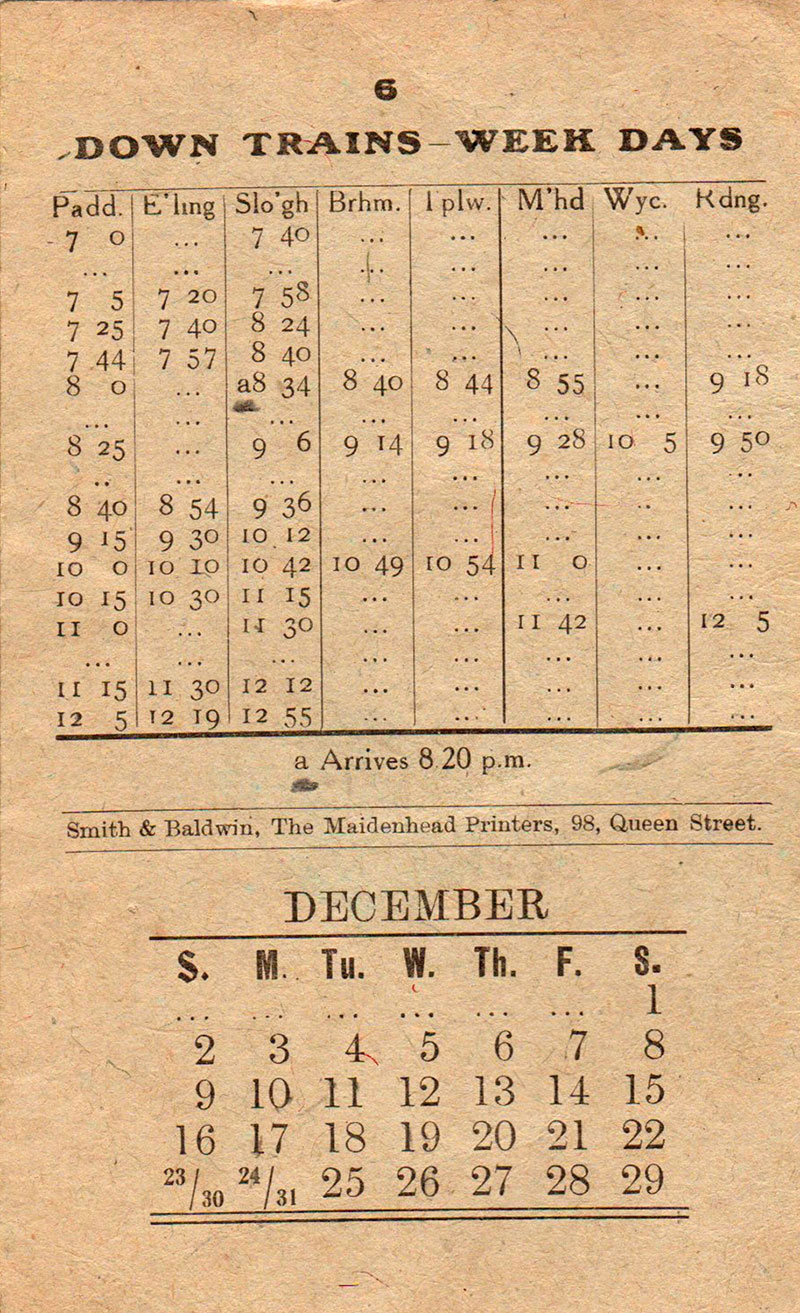
We are left to ponder how many monthly editions this garage put its name to, and over what annual period. Of course it may have irked the local station staff, as the GWR published their own pocket timetables for each main district – at a price of course, but frankly a free alternative was hardly likely to be ignored by the Station Garage Taplow customers.
Perhaps a Blog reader might be able to shine a light upon that garage and its history?
This very humble item, is just one of the many in our collection that provides a social history perspective upon the GWR, doing so from an unofficial direction but yet again proving how influential the GWR was, to a local business, even one dealing in a product and service directly in competition with that of a passenger focused railway!
Didcot Railway Centre Newsletter
Stay up to date with events and what's going on at Didcot Railway Centre.
You may unsubscribe at any time. We do not share your data with 3rd parties.